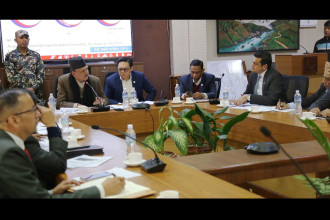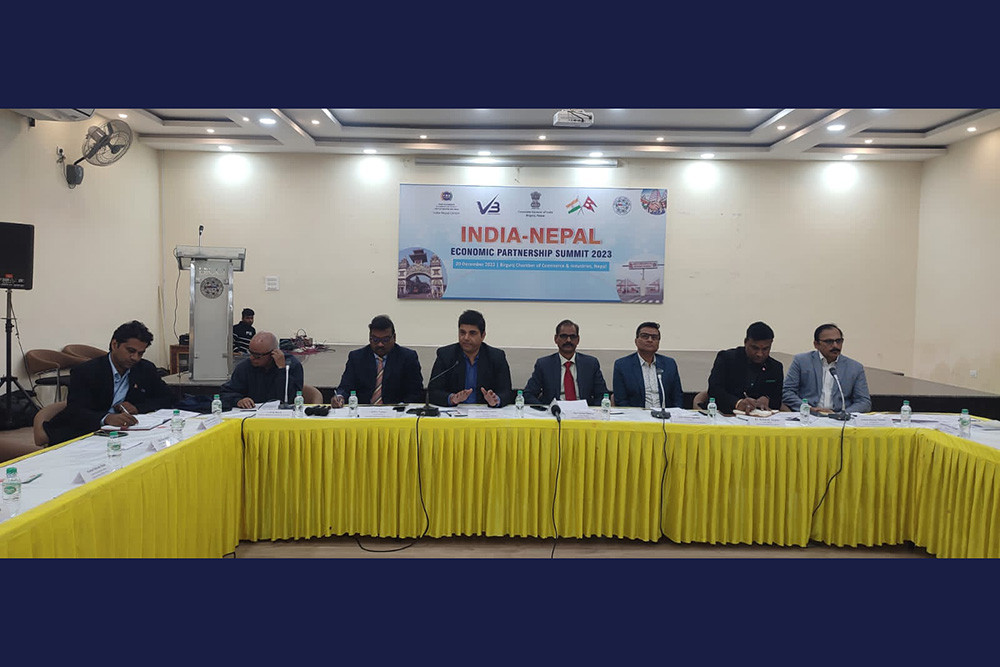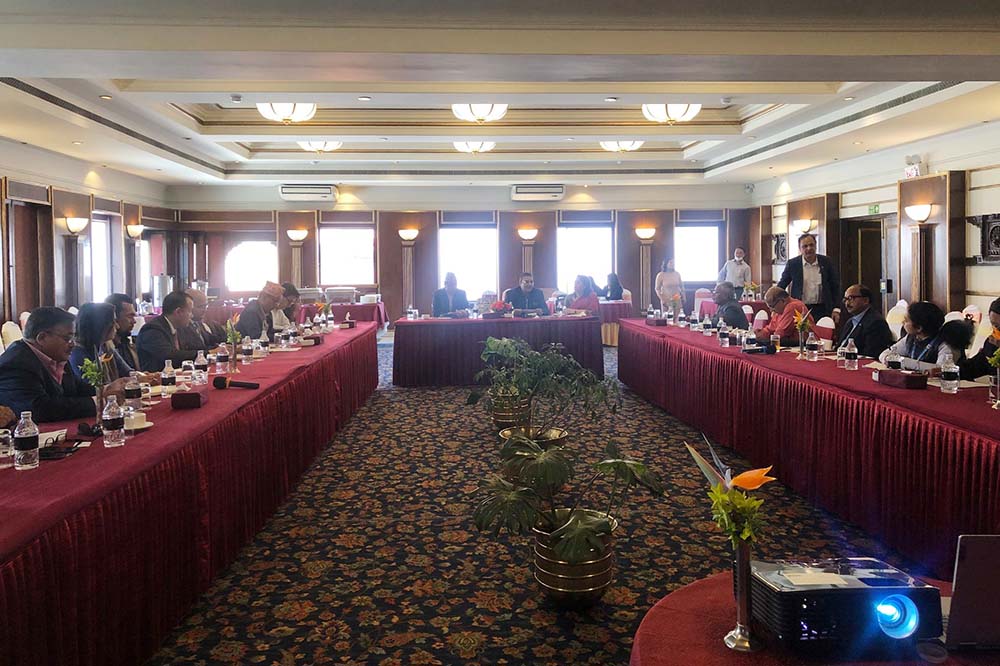
KATHMANDU: South Asia Watch on Trade, Economics and Environment (SAWTEE) on Thursday organised a roundtable discussion on the bilateral trade treaty.
The study carried out by SAWTEE on the topic was also presented at the discussion held in Kathmandu.
The roundtable discussion held the views that with the Nepal-India Treaty of Trade up for renewal this year, the Government of Nepal should seek revisions to the treaty geared towards removing barriers faced by Nepali goods in India, restoring Nepal’s policy space to protect its farmers from unfettered agricultural imports, and enabling Nepal to pursue preferential trade agreements with other countries,
The participants in the programme included trade experts, policymakers, exporters, importers and freight forwarders.
The trade treaty has a validity of seven years. It was last renewed in 2016 without any amendments.
Madhu Kumar Marasini, Secretary of the Ministry of Industry, Commerce and Supplies (MoICS), stated that three rounds of negotiations with India have already taken place in connection with revising the trade treaty. He said he was hopeful of reaching an agreement, taking into account as many suggestions from stakeholders, as possible. He added that without increasing productive capacity and production, changes in the treaty alone will not help boost exports.
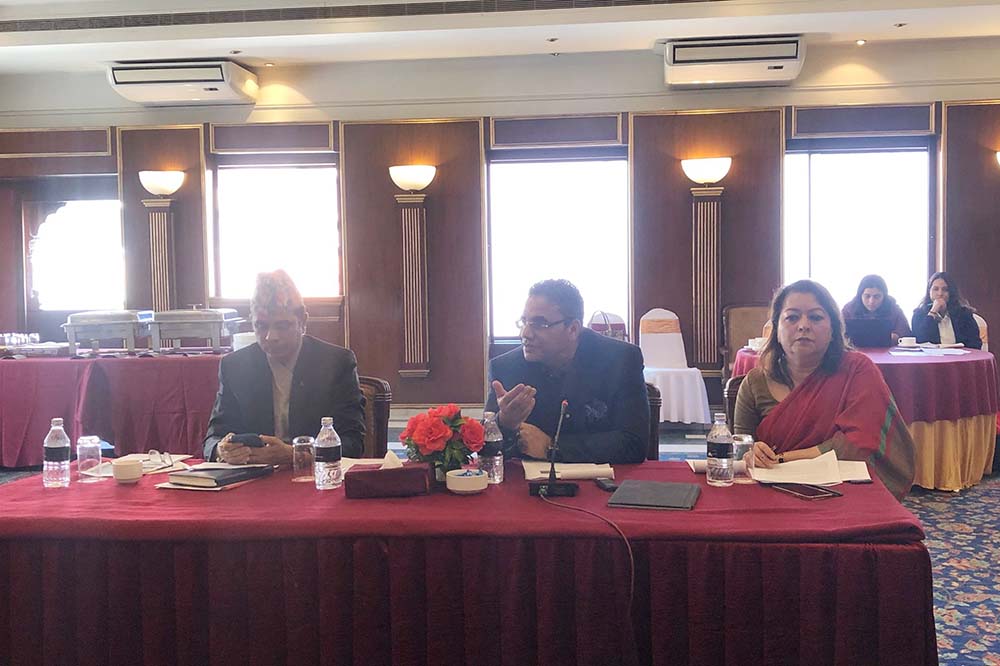 On the occasion, Nepal-India Chamber of Commerce and Industry (NICCI) President Shreejana Rana highlighted that NICCI and think tanks can play a big role in bridging the prevalent coordination gap between the private sector and the government. She further stressed that regular research on Nepal-India trade and continuous monitoring of the implementation of the bilateral trade treaty are urgently needed to realise the huge potential of mutually beneficial bilateral trade.
“Nepal can’t continue to afford to provide tariff-free access to heavily subsidised agricultural products from India. Therefore, select primary agricultural products, including cereals, must be removed from the list of primary products on which both countries are currently providing reciprocal tariff-free access,” said SAWTEE Chairman Posh Raj Pandey. He presented the think tank’s research on the treaty that suggests key areas for amendments. The research was supported by The Asia Foundation.
Nepal has the latitude to impose much higher tariffs than the agriculture reform fee of 5% or 9% it currently levies on certain agricultural products from India, thanks to the policy space it secured for itself when acceding to the World Trade Organization in 2004, but that option has been hamstrung by the Nepal-India trade treaty.
The list of primary products eligible for duty-free access must be accompanied by Harmonised System codes to avoid ambiguities regarding which products qualify for duty-free treatment and hence to remove possible arbitrariness in the application of this provision, said SAWTEE Chairman Pandey. In a similar vein, the list of primary agriculture products that are to be exempt from reciprocal duty-free access must also be specified in terms of HS codes.
While pushing for an amendment that allows Nepal to protect its agriculture sector through tariffs, the Government of Nepal should prepare a strategy for protecting vulnerable groups from a rise in food prices due to an increase in import prices that could result from tariff hikes, said Paras Kharel, Executive Director, SAWTEE, and a co-author of the study. He notes that possible measures include targeted subsidies and checking anti-competitive practices. He argues that if anti-competitive practices have, even with zero tariffs, led prices faced by Nepali consumers to significantly exceed the levels that would prevail in a competitive market, checking these practices could moderate or even offset the upward pressure on prices exerted by tariff increases.
On the occasion, Nepal-India Chamber of Commerce and Industry (NICCI) President Shreejana Rana highlighted that NICCI and think tanks can play a big role in bridging the prevalent coordination gap between the private sector and the government. She further stressed that regular research on Nepal-India trade and continuous monitoring of the implementation of the bilateral trade treaty are urgently needed to realise the huge potential of mutually beneficial bilateral trade.
“Nepal can’t continue to afford to provide tariff-free access to heavily subsidised agricultural products from India. Therefore, select primary agricultural products, including cereals, must be removed from the list of primary products on which both countries are currently providing reciprocal tariff-free access,” said SAWTEE Chairman Posh Raj Pandey. He presented the think tank’s research on the treaty that suggests key areas for amendments. The research was supported by The Asia Foundation.
Nepal has the latitude to impose much higher tariffs than the agriculture reform fee of 5% or 9% it currently levies on certain agricultural products from India, thanks to the policy space it secured for itself when acceding to the World Trade Organization in 2004, but that option has been hamstrung by the Nepal-India trade treaty.
The list of primary products eligible for duty-free access must be accompanied by Harmonised System codes to avoid ambiguities regarding which products qualify for duty-free treatment and hence to remove possible arbitrariness in the application of this provision, said SAWTEE Chairman Pandey. In a similar vein, the list of primary agriculture products that are to be exempt from reciprocal duty-free access must also be specified in terms of HS codes.
While pushing for an amendment that allows Nepal to protect its agriculture sector through tariffs, the Government of Nepal should prepare a strategy for protecting vulnerable groups from a rise in food prices due to an increase in import prices that could result from tariff hikes, said Paras Kharel, Executive Director, SAWTEE, and a co-author of the study. He notes that possible measures include targeted subsidies and checking anti-competitive practices. He argues that if anti-competitive practices have, even with zero tariffs, led prices faced by Nepali consumers to significantly exceed the levels that would prevail in a competitive market, checking these practices could moderate or even offset the upward pressure on prices exerted by tariff increases.
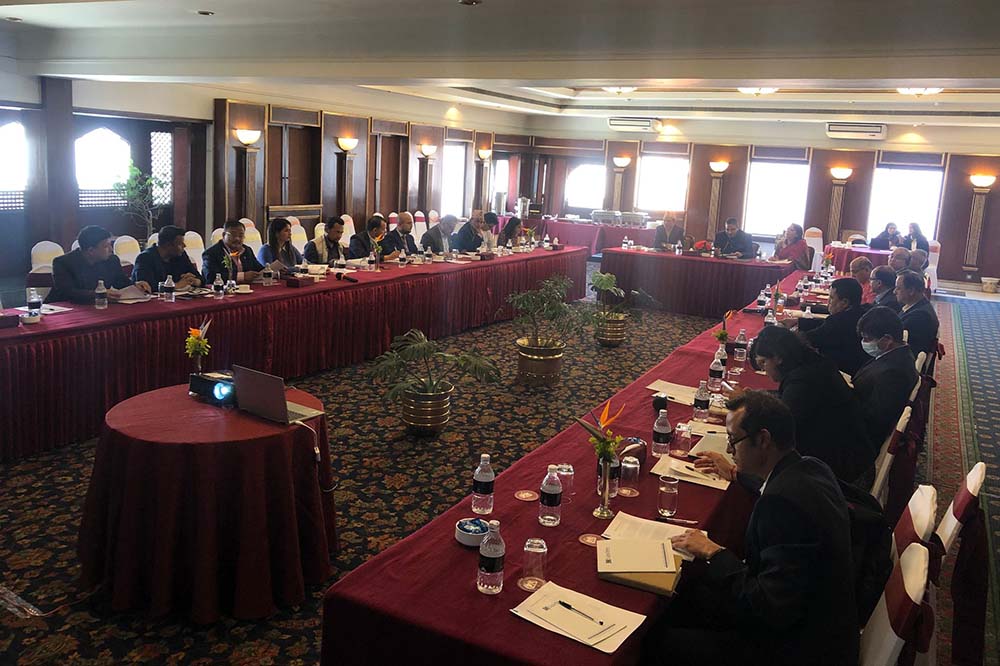 Touching on another dimension of policy space, the SAWTEE study identifies a provision in the treaty that restricts Nepal’s ability to negotiate preferential trade agreements. Article III of the treaty requires the two countries to extend to each other any trade preferences that they provide to a third country. This means, for example, that Nepal has to automatically extend to India any tariff concessions it grants Bangladesh, a South Asian neighbour with which Nepal is negotiating a preferential trade agreement. A number of trade agreements that India is party to do not have such a provision.
India has been imposing quotas on imports of vegetable ghee, acrylic yarn, copper products and zinc oxide from Nepal since 2002, when a number of trade restrictions were formally introduced during the treaty’s revision. There are no such permanent quotas in India’s global scheme of trade preferences granted to products originating in the least developed countries (LDCs) and in India’s scheme of preferential tariffs for products originating in LDC members of the Agreement on South Asian Free Trade Area (SAFTA). Imports within the quota are granted duty-free access whereas imports above the quota are subject to non-preferential tariffs. Participants in the roundtable called for scrapping the quotas.
SAWTEE research reveals, since there is already a provision in the treaty that allows the adoption of 'safeguard measures' to check imports in the event such imports cause or threaten to cause serious injury to domestic industry, the imposition of quotas is unduly restricting trade. Moreover, the administration of these quotas is riddled with hassles, designed to discourage imports even within the quota.
Nepali exports have also been constrained by stringent rules of origin: value addition of 30% and a change in tariff heading at the Harmonised System 4-digit level. These were introduced in the 2002 revision which marked a departure from the most liberal bilateral trade treaty of 1996. Roughly speaking, rules of origin are aimed at ensuring that only goods sufficiently originating in Nepal enjoy duty-free access to the Indian market. Interestingly, the treaty does not subject goods entering Nepal from India under tariff preferences to any rules of origin.
Pandey suggested that the twin rules of origin applicable to exports from Nepal be replaced with a single rule based solely on domestic value addition, in view of Nepal’s weak industrial base, low productive capacity and supply-side constraints and the preference erosion experienced by Nepali exporters in the Indian market as a result of India’s providing generous tariff concessions to other countries unilaterally or as part of free trade agreements. Setting the required domestic value addition at 25%, down from 30% in the existing treaty, would make the rules of origin in the Nepal-India treaty consistent with the agreement on simplified and preferential rules of origin for LDCs reached among WTO members, including India, in the 2015 Nairobi Ministerial Conference of the WTO.
Nepali jute products have been subject to anti-dumping duties in India for the last seven years. In theory, dumping is said to occur when goods are exported for less than they are sold in the domestic market or third-country markets, or at less than the production cost. Nepali jute product manufacturers say they are not doing so. On this issue, Pandey pointed out that as per WTO rules, anti-dumping duties can be imposed only if dumped exports are causing material injury to domestic industry, and expressed doubt that Nepali jute products were causing material injury to India’s domestic jute manufacturers.
Nepal Jute Mills Association President Raj Kumar Golchha, in a statement, says India continued with the anti-dumping duties on Nepali jute products for another five years in late 2022 even though India’s Directorate General of Trade Remedies had, following a detailed investigation, concluded that anti-dumping duties will not be applicable to Nepali jute products. He points out that Nepali jute product exporters source 40% of their raw jute from India, their products make up less than 2% of the Indian market, and they also source machinery and parts from India.
Procedural irritants in the export of, for example, pharmaceutical products, vegetables, and medicinal and aromatic plants from Nepal in form of inspection, import licensing, certification and registration requirements must be addressed. Since testing and certification issues are considered to be major barriers to Nepali exports of items like cardamom, ginger, and other agricultural and food products, provisions in the treaty that aim to address them must be strengthened and effectively implemented, suggested Kshitiz Dahal, Senior Research Officer at SAWTEE, and a co-author of the study.
In Para 6 of Protocol to Article II of the treaty, both countries have agreed to grant recognition to the sanitary and phytosanitary certificates (including health certificates) issued by the competent authority of the exporting country with regard to agricultural and food products. Proper implementation of this provision has to be ensured so that conformity assessment measures do not result in duplicate efforts (double testing and certification) and undue burden to Nepali exporters, notably small and medium enterprises. In cases where Nepal lacks competency for product testing and certification, India’s assistance to improve testing capacities for the products of interest to Nepal must be sought and provided, as agreed upon in Para 3 of Protocol to Article I.
There are also provisions in the treaty that could benefit Nepal but whose implementation status is weak or ambiguous. SAWTEE research points out that Para 3 of the Protocol to Article V provides for India granting relief in the application of excise duty on manufactures produced in small-scale units in Nepal to the extent such relief is provided to such products produced in small-scale units in India. Now that the excise duty has been subsumed under the Goods and Services Tax (GST), introduced in 2017, the provision should be amended to reflect the GST regime. Moreover, the extent to which the existing provision was utilised by Nepali manufacturers should be investigated and measures should be taken to increase the utilisation rate if it is found low.
Likewise, there is a need for effectively operationalising the provision for joint meeting of local authorities, argued Rabi Shanker Sainju, former Joint Secretary of MOICS, who led bilateral trade and transit negotiations with India. The Protocol to Article XI of the treaty provides for joint meetings of local authorities comprising customs officers, quarantine/food test officers, local chambers’ representatives, and any other local officials nominated by the respective governments, in order to resolve problems arising in the clearance of goods at the land customs stations. At present, the meetings are limited to customs officials and the mandate is not clear, said Sainju, adding that there is a need to enlist the participation of all the relevant agencies, and provide a clear mandate to the joint committee through terms of reference.
At present, bilateral trade disputes are generally discussed in the meetings of the Intergovernmental Committee (IGC), led by the Commerce Secretaries of the two governments, and the Inter-Governmental Sub-Committee (IGSC), led by the respective joint secretaries. Disputes are also raised through diplomatic channels. This is not an effective way to resolve disputes, said Sainju, emphasizing the need for a clearly specified dispute settlement mechanism or grievance redressal mechanism.
READ ALSO:
Touching on another dimension of policy space, the SAWTEE study identifies a provision in the treaty that restricts Nepal’s ability to negotiate preferential trade agreements. Article III of the treaty requires the two countries to extend to each other any trade preferences that they provide to a third country. This means, for example, that Nepal has to automatically extend to India any tariff concessions it grants Bangladesh, a South Asian neighbour with which Nepal is negotiating a preferential trade agreement. A number of trade agreements that India is party to do not have such a provision.
India has been imposing quotas on imports of vegetable ghee, acrylic yarn, copper products and zinc oxide from Nepal since 2002, when a number of trade restrictions were formally introduced during the treaty’s revision. There are no such permanent quotas in India’s global scheme of trade preferences granted to products originating in the least developed countries (LDCs) and in India’s scheme of preferential tariffs for products originating in LDC members of the Agreement on South Asian Free Trade Area (SAFTA). Imports within the quota are granted duty-free access whereas imports above the quota are subject to non-preferential tariffs. Participants in the roundtable called for scrapping the quotas.
SAWTEE research reveals, since there is already a provision in the treaty that allows the adoption of 'safeguard measures' to check imports in the event such imports cause or threaten to cause serious injury to domestic industry, the imposition of quotas is unduly restricting trade. Moreover, the administration of these quotas is riddled with hassles, designed to discourage imports even within the quota.
Nepali exports have also been constrained by stringent rules of origin: value addition of 30% and a change in tariff heading at the Harmonised System 4-digit level. These were introduced in the 2002 revision which marked a departure from the most liberal bilateral trade treaty of 1996. Roughly speaking, rules of origin are aimed at ensuring that only goods sufficiently originating in Nepal enjoy duty-free access to the Indian market. Interestingly, the treaty does not subject goods entering Nepal from India under tariff preferences to any rules of origin.
Pandey suggested that the twin rules of origin applicable to exports from Nepal be replaced with a single rule based solely on domestic value addition, in view of Nepal’s weak industrial base, low productive capacity and supply-side constraints and the preference erosion experienced by Nepali exporters in the Indian market as a result of India’s providing generous tariff concessions to other countries unilaterally or as part of free trade agreements. Setting the required domestic value addition at 25%, down from 30% in the existing treaty, would make the rules of origin in the Nepal-India treaty consistent with the agreement on simplified and preferential rules of origin for LDCs reached among WTO members, including India, in the 2015 Nairobi Ministerial Conference of the WTO.
Nepali jute products have been subject to anti-dumping duties in India for the last seven years. In theory, dumping is said to occur when goods are exported for less than they are sold in the domestic market or third-country markets, or at less than the production cost. Nepali jute product manufacturers say they are not doing so. On this issue, Pandey pointed out that as per WTO rules, anti-dumping duties can be imposed only if dumped exports are causing material injury to domestic industry, and expressed doubt that Nepali jute products were causing material injury to India’s domestic jute manufacturers.
Nepal Jute Mills Association President Raj Kumar Golchha, in a statement, says India continued with the anti-dumping duties on Nepali jute products for another five years in late 2022 even though India’s Directorate General of Trade Remedies had, following a detailed investigation, concluded that anti-dumping duties will not be applicable to Nepali jute products. He points out that Nepali jute product exporters source 40% of their raw jute from India, their products make up less than 2% of the Indian market, and they also source machinery and parts from India.
Procedural irritants in the export of, for example, pharmaceutical products, vegetables, and medicinal and aromatic plants from Nepal in form of inspection, import licensing, certification and registration requirements must be addressed. Since testing and certification issues are considered to be major barriers to Nepali exports of items like cardamom, ginger, and other agricultural and food products, provisions in the treaty that aim to address them must be strengthened and effectively implemented, suggested Kshitiz Dahal, Senior Research Officer at SAWTEE, and a co-author of the study.
In Para 6 of Protocol to Article II of the treaty, both countries have agreed to grant recognition to the sanitary and phytosanitary certificates (including health certificates) issued by the competent authority of the exporting country with regard to agricultural and food products. Proper implementation of this provision has to be ensured so that conformity assessment measures do not result in duplicate efforts (double testing and certification) and undue burden to Nepali exporters, notably small and medium enterprises. In cases where Nepal lacks competency for product testing and certification, India’s assistance to improve testing capacities for the products of interest to Nepal must be sought and provided, as agreed upon in Para 3 of Protocol to Article I.
There are also provisions in the treaty that could benefit Nepal but whose implementation status is weak or ambiguous. SAWTEE research points out that Para 3 of the Protocol to Article V provides for India granting relief in the application of excise duty on manufactures produced in small-scale units in Nepal to the extent such relief is provided to such products produced in small-scale units in India. Now that the excise duty has been subsumed under the Goods and Services Tax (GST), introduced in 2017, the provision should be amended to reflect the GST regime. Moreover, the extent to which the existing provision was utilised by Nepali manufacturers should be investigated and measures should be taken to increase the utilisation rate if it is found low.
Likewise, there is a need for effectively operationalising the provision for joint meeting of local authorities, argued Rabi Shanker Sainju, former Joint Secretary of MOICS, who led bilateral trade and transit negotiations with India. The Protocol to Article XI of the treaty provides for joint meetings of local authorities comprising customs officers, quarantine/food test officers, local chambers’ representatives, and any other local officials nominated by the respective governments, in order to resolve problems arising in the clearance of goods at the land customs stations. At present, the meetings are limited to customs officials and the mandate is not clear, said Sainju, adding that there is a need to enlist the participation of all the relevant agencies, and provide a clear mandate to the joint committee through terms of reference.
At present, bilateral trade disputes are generally discussed in the meetings of the Intergovernmental Committee (IGC), led by the Commerce Secretaries of the two governments, and the Inter-Governmental Sub-Committee (IGSC), led by the respective joint secretaries. Disputes are also raised through diplomatic channels. This is not an effective way to resolve disputes, said Sainju, emphasizing the need for a clearly specified dispute settlement mechanism or grievance redressal mechanism.
READ ALSO:
 On the occasion, Nepal-India Chamber of Commerce and Industry (NICCI) President Shreejana Rana highlighted that NICCI and think tanks can play a big role in bridging the prevalent coordination gap between the private sector and the government. She further stressed that regular research on Nepal-India trade and continuous monitoring of the implementation of the bilateral trade treaty are urgently needed to realise the huge potential of mutually beneficial bilateral trade.
“Nepal can’t continue to afford to provide tariff-free access to heavily subsidised agricultural products from India. Therefore, select primary agricultural products, including cereals, must be removed from the list of primary products on which both countries are currently providing reciprocal tariff-free access,” said SAWTEE Chairman Posh Raj Pandey. He presented the think tank’s research on the treaty that suggests key areas for amendments. The research was supported by The Asia Foundation.
Nepal has the latitude to impose much higher tariffs than the agriculture reform fee of 5% or 9% it currently levies on certain agricultural products from India, thanks to the policy space it secured for itself when acceding to the World Trade Organization in 2004, but that option has been hamstrung by the Nepal-India trade treaty.
The list of primary products eligible for duty-free access must be accompanied by Harmonised System codes to avoid ambiguities regarding which products qualify for duty-free treatment and hence to remove possible arbitrariness in the application of this provision, said SAWTEE Chairman Pandey. In a similar vein, the list of primary agriculture products that are to be exempt from reciprocal duty-free access must also be specified in terms of HS codes.
While pushing for an amendment that allows Nepal to protect its agriculture sector through tariffs, the Government of Nepal should prepare a strategy for protecting vulnerable groups from a rise in food prices due to an increase in import prices that could result from tariff hikes, said Paras Kharel, Executive Director, SAWTEE, and a co-author of the study. He notes that possible measures include targeted subsidies and checking anti-competitive practices. He argues that if anti-competitive practices have, even with zero tariffs, led prices faced by Nepali consumers to significantly exceed the levels that would prevail in a competitive market, checking these practices could moderate or even offset the upward pressure on prices exerted by tariff increases.
On the occasion, Nepal-India Chamber of Commerce and Industry (NICCI) President Shreejana Rana highlighted that NICCI and think tanks can play a big role in bridging the prevalent coordination gap between the private sector and the government. She further stressed that regular research on Nepal-India trade and continuous monitoring of the implementation of the bilateral trade treaty are urgently needed to realise the huge potential of mutually beneficial bilateral trade.
“Nepal can’t continue to afford to provide tariff-free access to heavily subsidised agricultural products from India. Therefore, select primary agricultural products, including cereals, must be removed from the list of primary products on which both countries are currently providing reciprocal tariff-free access,” said SAWTEE Chairman Posh Raj Pandey. He presented the think tank’s research on the treaty that suggests key areas for amendments. The research was supported by The Asia Foundation.
Nepal has the latitude to impose much higher tariffs than the agriculture reform fee of 5% or 9% it currently levies on certain agricultural products from India, thanks to the policy space it secured for itself when acceding to the World Trade Organization in 2004, but that option has been hamstrung by the Nepal-India trade treaty.
The list of primary products eligible for duty-free access must be accompanied by Harmonised System codes to avoid ambiguities regarding which products qualify for duty-free treatment and hence to remove possible arbitrariness in the application of this provision, said SAWTEE Chairman Pandey. In a similar vein, the list of primary agriculture products that are to be exempt from reciprocal duty-free access must also be specified in terms of HS codes.
While pushing for an amendment that allows Nepal to protect its agriculture sector through tariffs, the Government of Nepal should prepare a strategy for protecting vulnerable groups from a rise in food prices due to an increase in import prices that could result from tariff hikes, said Paras Kharel, Executive Director, SAWTEE, and a co-author of the study. He notes that possible measures include targeted subsidies and checking anti-competitive practices. He argues that if anti-competitive practices have, even with zero tariffs, led prices faced by Nepali consumers to significantly exceed the levels that would prevail in a competitive market, checking these practices could moderate or even offset the upward pressure on prices exerted by tariff increases.
 Touching on another dimension of policy space, the SAWTEE study identifies a provision in the treaty that restricts Nepal’s ability to negotiate preferential trade agreements. Article III of the treaty requires the two countries to extend to each other any trade preferences that they provide to a third country. This means, for example, that Nepal has to automatically extend to India any tariff concessions it grants Bangladesh, a South Asian neighbour with which Nepal is negotiating a preferential trade agreement. A number of trade agreements that India is party to do not have such a provision.
India has been imposing quotas on imports of vegetable ghee, acrylic yarn, copper products and zinc oxide from Nepal since 2002, when a number of trade restrictions were formally introduced during the treaty’s revision. There are no such permanent quotas in India’s global scheme of trade preferences granted to products originating in the least developed countries (LDCs) and in India’s scheme of preferential tariffs for products originating in LDC members of the Agreement on South Asian Free Trade Area (SAFTA). Imports within the quota are granted duty-free access whereas imports above the quota are subject to non-preferential tariffs. Participants in the roundtable called for scrapping the quotas.
SAWTEE research reveals, since there is already a provision in the treaty that allows the adoption of 'safeguard measures' to check imports in the event such imports cause or threaten to cause serious injury to domestic industry, the imposition of quotas is unduly restricting trade. Moreover, the administration of these quotas is riddled with hassles, designed to discourage imports even within the quota.
Nepali exports have also been constrained by stringent rules of origin: value addition of 30% and a change in tariff heading at the Harmonised System 4-digit level. These were introduced in the 2002 revision which marked a departure from the most liberal bilateral trade treaty of 1996. Roughly speaking, rules of origin are aimed at ensuring that only goods sufficiently originating in Nepal enjoy duty-free access to the Indian market. Interestingly, the treaty does not subject goods entering Nepal from India under tariff preferences to any rules of origin.
Pandey suggested that the twin rules of origin applicable to exports from Nepal be replaced with a single rule based solely on domestic value addition, in view of Nepal’s weak industrial base, low productive capacity and supply-side constraints and the preference erosion experienced by Nepali exporters in the Indian market as a result of India’s providing generous tariff concessions to other countries unilaterally or as part of free trade agreements. Setting the required domestic value addition at 25%, down from 30% in the existing treaty, would make the rules of origin in the Nepal-India treaty consistent with the agreement on simplified and preferential rules of origin for LDCs reached among WTO members, including India, in the 2015 Nairobi Ministerial Conference of the WTO.
Nepali jute products have been subject to anti-dumping duties in India for the last seven years. In theory, dumping is said to occur when goods are exported for less than they are sold in the domestic market or third-country markets, or at less than the production cost. Nepali jute product manufacturers say they are not doing so. On this issue, Pandey pointed out that as per WTO rules, anti-dumping duties can be imposed only if dumped exports are causing material injury to domestic industry, and expressed doubt that Nepali jute products were causing material injury to India’s domestic jute manufacturers.
Nepal Jute Mills Association President Raj Kumar Golchha, in a statement, says India continued with the anti-dumping duties on Nepali jute products for another five years in late 2022 even though India’s Directorate General of Trade Remedies had, following a detailed investigation, concluded that anti-dumping duties will not be applicable to Nepali jute products. He points out that Nepali jute product exporters source 40% of their raw jute from India, their products make up less than 2% of the Indian market, and they also source machinery and parts from India.
Procedural irritants in the export of, for example, pharmaceutical products, vegetables, and medicinal and aromatic plants from Nepal in form of inspection, import licensing, certification and registration requirements must be addressed. Since testing and certification issues are considered to be major barriers to Nepali exports of items like cardamom, ginger, and other agricultural and food products, provisions in the treaty that aim to address them must be strengthened and effectively implemented, suggested Kshitiz Dahal, Senior Research Officer at SAWTEE, and a co-author of the study.
In Para 6 of Protocol to Article II of the treaty, both countries have agreed to grant recognition to the sanitary and phytosanitary certificates (including health certificates) issued by the competent authority of the exporting country with regard to agricultural and food products. Proper implementation of this provision has to be ensured so that conformity assessment measures do not result in duplicate efforts (double testing and certification) and undue burden to Nepali exporters, notably small and medium enterprises. In cases where Nepal lacks competency for product testing and certification, India’s assistance to improve testing capacities for the products of interest to Nepal must be sought and provided, as agreed upon in Para 3 of Protocol to Article I.
There are also provisions in the treaty that could benefit Nepal but whose implementation status is weak or ambiguous. SAWTEE research points out that Para 3 of the Protocol to Article V provides for India granting relief in the application of excise duty on manufactures produced in small-scale units in Nepal to the extent such relief is provided to such products produced in small-scale units in India. Now that the excise duty has been subsumed under the Goods and Services Tax (GST), introduced in 2017, the provision should be amended to reflect the GST regime. Moreover, the extent to which the existing provision was utilised by Nepali manufacturers should be investigated and measures should be taken to increase the utilisation rate if it is found low.
Likewise, there is a need for effectively operationalising the provision for joint meeting of local authorities, argued Rabi Shanker Sainju, former Joint Secretary of MOICS, who led bilateral trade and transit negotiations with India. The Protocol to Article XI of the treaty provides for joint meetings of local authorities comprising customs officers, quarantine/food test officers, local chambers’ representatives, and any other local officials nominated by the respective governments, in order to resolve problems arising in the clearance of goods at the land customs stations. At present, the meetings are limited to customs officials and the mandate is not clear, said Sainju, adding that there is a need to enlist the participation of all the relevant agencies, and provide a clear mandate to the joint committee through terms of reference.
At present, bilateral trade disputes are generally discussed in the meetings of the Intergovernmental Committee (IGC), led by the Commerce Secretaries of the two governments, and the Inter-Governmental Sub-Committee (IGSC), led by the respective joint secretaries. Disputes are also raised through diplomatic channels. This is not an effective way to resolve disputes, said Sainju, emphasizing the need for a clearly specified dispute settlement mechanism or grievance redressal mechanism.
READ ALSO:
Touching on another dimension of policy space, the SAWTEE study identifies a provision in the treaty that restricts Nepal’s ability to negotiate preferential trade agreements. Article III of the treaty requires the two countries to extend to each other any trade preferences that they provide to a third country. This means, for example, that Nepal has to automatically extend to India any tariff concessions it grants Bangladesh, a South Asian neighbour with which Nepal is negotiating a preferential trade agreement. A number of trade agreements that India is party to do not have such a provision.
India has been imposing quotas on imports of vegetable ghee, acrylic yarn, copper products and zinc oxide from Nepal since 2002, when a number of trade restrictions were formally introduced during the treaty’s revision. There are no such permanent quotas in India’s global scheme of trade preferences granted to products originating in the least developed countries (LDCs) and in India’s scheme of preferential tariffs for products originating in LDC members of the Agreement on South Asian Free Trade Area (SAFTA). Imports within the quota are granted duty-free access whereas imports above the quota are subject to non-preferential tariffs. Participants in the roundtable called for scrapping the quotas.
SAWTEE research reveals, since there is already a provision in the treaty that allows the adoption of 'safeguard measures' to check imports in the event such imports cause or threaten to cause serious injury to domestic industry, the imposition of quotas is unduly restricting trade. Moreover, the administration of these quotas is riddled with hassles, designed to discourage imports even within the quota.
Nepali exports have also been constrained by stringent rules of origin: value addition of 30% and a change in tariff heading at the Harmonised System 4-digit level. These were introduced in the 2002 revision which marked a departure from the most liberal bilateral trade treaty of 1996. Roughly speaking, rules of origin are aimed at ensuring that only goods sufficiently originating in Nepal enjoy duty-free access to the Indian market. Interestingly, the treaty does not subject goods entering Nepal from India under tariff preferences to any rules of origin.
Pandey suggested that the twin rules of origin applicable to exports from Nepal be replaced with a single rule based solely on domestic value addition, in view of Nepal’s weak industrial base, low productive capacity and supply-side constraints and the preference erosion experienced by Nepali exporters in the Indian market as a result of India’s providing generous tariff concessions to other countries unilaterally or as part of free trade agreements. Setting the required domestic value addition at 25%, down from 30% in the existing treaty, would make the rules of origin in the Nepal-India treaty consistent with the agreement on simplified and preferential rules of origin for LDCs reached among WTO members, including India, in the 2015 Nairobi Ministerial Conference of the WTO.
Nepali jute products have been subject to anti-dumping duties in India for the last seven years. In theory, dumping is said to occur when goods are exported for less than they are sold in the domestic market or third-country markets, or at less than the production cost. Nepali jute product manufacturers say they are not doing so. On this issue, Pandey pointed out that as per WTO rules, anti-dumping duties can be imposed only if dumped exports are causing material injury to domestic industry, and expressed doubt that Nepali jute products were causing material injury to India’s domestic jute manufacturers.
Nepal Jute Mills Association President Raj Kumar Golchha, in a statement, says India continued with the anti-dumping duties on Nepali jute products for another five years in late 2022 even though India’s Directorate General of Trade Remedies had, following a detailed investigation, concluded that anti-dumping duties will not be applicable to Nepali jute products. He points out that Nepali jute product exporters source 40% of their raw jute from India, their products make up less than 2% of the Indian market, and they also source machinery and parts from India.
Procedural irritants in the export of, for example, pharmaceutical products, vegetables, and medicinal and aromatic plants from Nepal in form of inspection, import licensing, certification and registration requirements must be addressed. Since testing and certification issues are considered to be major barriers to Nepali exports of items like cardamom, ginger, and other agricultural and food products, provisions in the treaty that aim to address them must be strengthened and effectively implemented, suggested Kshitiz Dahal, Senior Research Officer at SAWTEE, and a co-author of the study.
In Para 6 of Protocol to Article II of the treaty, both countries have agreed to grant recognition to the sanitary and phytosanitary certificates (including health certificates) issued by the competent authority of the exporting country with regard to agricultural and food products. Proper implementation of this provision has to be ensured so that conformity assessment measures do not result in duplicate efforts (double testing and certification) and undue burden to Nepali exporters, notably small and medium enterprises. In cases where Nepal lacks competency for product testing and certification, India’s assistance to improve testing capacities for the products of interest to Nepal must be sought and provided, as agreed upon in Para 3 of Protocol to Article I.
There are also provisions in the treaty that could benefit Nepal but whose implementation status is weak or ambiguous. SAWTEE research points out that Para 3 of the Protocol to Article V provides for India granting relief in the application of excise duty on manufactures produced in small-scale units in Nepal to the extent such relief is provided to such products produced in small-scale units in India. Now that the excise duty has been subsumed under the Goods and Services Tax (GST), introduced in 2017, the provision should be amended to reflect the GST regime. Moreover, the extent to which the existing provision was utilised by Nepali manufacturers should be investigated and measures should be taken to increase the utilisation rate if it is found low.
Likewise, there is a need for effectively operationalising the provision for joint meeting of local authorities, argued Rabi Shanker Sainju, former Joint Secretary of MOICS, who led bilateral trade and transit negotiations with India. The Protocol to Article XI of the treaty provides for joint meetings of local authorities comprising customs officers, quarantine/food test officers, local chambers’ representatives, and any other local officials nominated by the respective governments, in order to resolve problems arising in the clearance of goods at the land customs stations. At present, the meetings are limited to customs officials and the mandate is not clear, said Sainju, adding that there is a need to enlist the participation of all the relevant agencies, and provide a clear mandate to the joint committee through terms of reference.
At present, bilateral trade disputes are generally discussed in the meetings of the Intergovernmental Committee (IGC), led by the Commerce Secretaries of the two governments, and the Inter-Governmental Sub-Committee (IGSC), led by the respective joint secretaries. Disputes are also raised through diplomatic channels. This is not an effective way to resolve disputes, said Sainju, emphasizing the need for a clearly specified dispute settlement mechanism or grievance redressal mechanism.
READ ALSO:
- SAWTEE, TAF hold seminar on trade policy and economic diplomacy
- SAWTEE organised virtual meeting on “Impact of Covid 19 on tourism and revival strategies of South Asian countries”
- South Asia’s handling of Covid 19 crisis portends a dire situation for the region’s response to the climate change crisis, say SAWTEE experts
Published Date: April 7, 2023, 12:00 am
Post Comment
E-Magazine
RELATED B360 National


